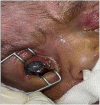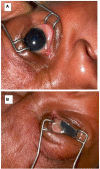Ophthalmomyiasis in a preterm neonate resulting in blindness: A case report from Botswana
- PMID: 36245720
- PMCID: PMC9557118
- DOI: 10.3389/fped.2022.955212
Ophthalmomyiasis in a preterm neonate resulting in blindness: A case report from Botswana
Abstract
Myiasis is an infestation of human tissue by insect larvae. While rare, healthcare-associated myiasis has been reported from immobilized patients in resource-limited healthcare facilities in warm climates without adequate vector control measures. We describe a case of Ophthalmomyiasis in a hospitalized neonate in Botswana that resulted in vision loss. The neonate, who was initially hospitalized due to the complications of prematurity, received phototherapy for jaundice, and to avoid phototherapy-related retinopathy, the neonate's eyes were covered using cotton gauze and adhesive tapes that potentially damaged the skin as commercially available eye covering was not in stock. Therefore, eye covering was not changed and when the eye covering was removed almost 3 days after placement, insect larvae were noted in the patient's eyes and nose. Ophthalmologic evaluation revealed perforated corneal ulcer and uveal prolapse in the right eye resulting in complete blindness and corneal scarring of the left eye. The patient's clinical course was further complicated by an Enterobacter species bloodstream infection. This case highlights the importance of vector control as a major patient safety measure for neonatal units in warm climates. Flies had been observed in the room and mitigation measures included reducing fly populations through traps, screens, and removal of standing water and leftover food. Every mother and staff were sanitizing hands when entering the room and gowns were used. This case also reinforces the importance to conduct vigilant monitoring of patients, especially neonates with eyes covered during phototherapy.
Keywords: blindness; eye-covering during phototherpy; jaundice; ophthalmomyiasis; preterm neonate.
Copyright © 2022 Nakstad, Zandile, Gaebolae, Banda, Dinotshe, Imran and Gezmu.
Conflict of interest statement
The authors declare that the research was conducted in the absence of any commercial or financial relationships that could be construed as a potential conflict of interest.
Figures
Similar articles
-
Concurrent ophthalmomyiasis externa and aural myiasis: A case report in an urban hospital in the United States.Am J Ophthalmol Case Rep. 2020 Jan 8;17:100590. doi: 10.1016/j.ajoc.2020.100590. eCollection 2020 Mar. Am J Ophthalmol Case Rep. 2020. PMID: 32021944 Free PMC article.
-
Vidi, vini, vinci: External ophthalmomyiasis infection that occurred, and was diagnosed and treated in a single day: A rare case report.Oman J Ophthalmol. 2009 Sep;2(3):130-2. doi: 10.4103/0974-620X.57313. Oman J Ophthalmol. 2009. PMID: 20927210 Free PMC article.
-
Ophthalmomyiasis externa: A case report from Alkharj, Saudi Arabia.Saudi J Ophthalmol. 2018 Jul-Sep;32(3):250-252. doi: 10.1016/j.sjopt.2017.11.005. Epub 2017 Nov 24. Saudi J Ophthalmol. 2018. PMID: 30224893 Free PMC article.
-
[Ophthalmomyiasis externa acquired in Germany: case report and review of the literature].Ophthalmologica. 2001 Sep-Oct;215(5):383-6. doi: 10.1159/000050891. Ophthalmologica. 2001. PMID: 11528267 Review. German.
-
Ophthalmomyiasis: a review with special reference to Cochliomyia hominivorax.Clin Infect Dis. 1992 Feb;14(2):444-9. doi: 10.1093/clinids/14.2.444. Clin Infect Dis. 1992. PMID: 1554829 Review.
References
Publication types
LinkOut - more resources
Full Text Sources




